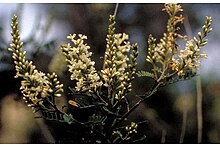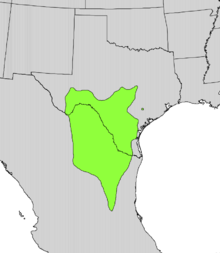Eysenhardtia texana
| Eysenhardtia texana | |
|---|---|

| |
| Scientific classification | |
| Kingdom: | Plantae |
| Clade: | Tracheophytes |
| Clade: | Angiosperms |
| Clade: | Eudicots |
| Clade: | Rosids |
| Order: | Fabales |
| Family: | Fabaceae |
| Genus: | Eysenhardtia |
| Species: | E. texana
|
| Binomial name | |
| Eysenhardtia texana | |

| |
| Natural range | |
Eysenhardtia texana, commonly known as Texas kidneywood, bee-brush, or vara dulce,[1] is a species of small flowering tree in the legume family, Fabaceae. It is found from south-central Texas south to northern San Luis Potosí in the Rio Grande Valley region of south Texas–Northeastern Mexico, and the species ranges into the eastern Chihuahuan Desert areas of Coahuila.[2]
Distribution[]
The contiguous range of Texas kidneywood covers the three neighboring Mexican states of Coahuila, Nuevo Leon, and Tamaulipas in northeast Mexico, the Rio Grande valley, from Big Bend southeastwards, but not the coastal Gulf of Mexico areas, only 25–50 miles inland. Part of the range extends southwards into extreme northern San Luis Potosí,[2] and some isolated locales towards east-central and southern Texas.
References[]
- ^ "Eysenhardtia texana Scheele Texas kidneywood, Kidneywood, Bee-Brush, Vara dulce". Native Plant Information Network. Lady Bird Johnson Wildflower Center.
- ^ Jump up to: a b Little Jr., Elbert L. (1976). "Map 71, Eysenhardtia texana". Atlas of United States Trees. 3 (Minor Western Hardwoods). US Government Printing Office. LCCN 79-653298. OCLC 4053799.
External links[]
| Wikispecies has information related to Eysenhardtia texana. |
- Lady Bird Johnson database, w/ gallery
- NRCS: USDA Plants Profile
- Interactive Distribution Map of Eysenhardtia texana
- NatureServe secure species
- Eysenhardtia
- Plants described in 1848
- North American desert flora
- Trees of the Southwestern United States
- Flora of the U.S. Rio Grande Valleys
- Flora of the Chihuahuan Desert
- Trees of the South-Central United States
- Trees of Coahuila
- Trees of Nuevo León
- Trees of Tamaulipas
- Trees of San Luis Potosí
- Mexican Plateau
- Faboideae stubs
